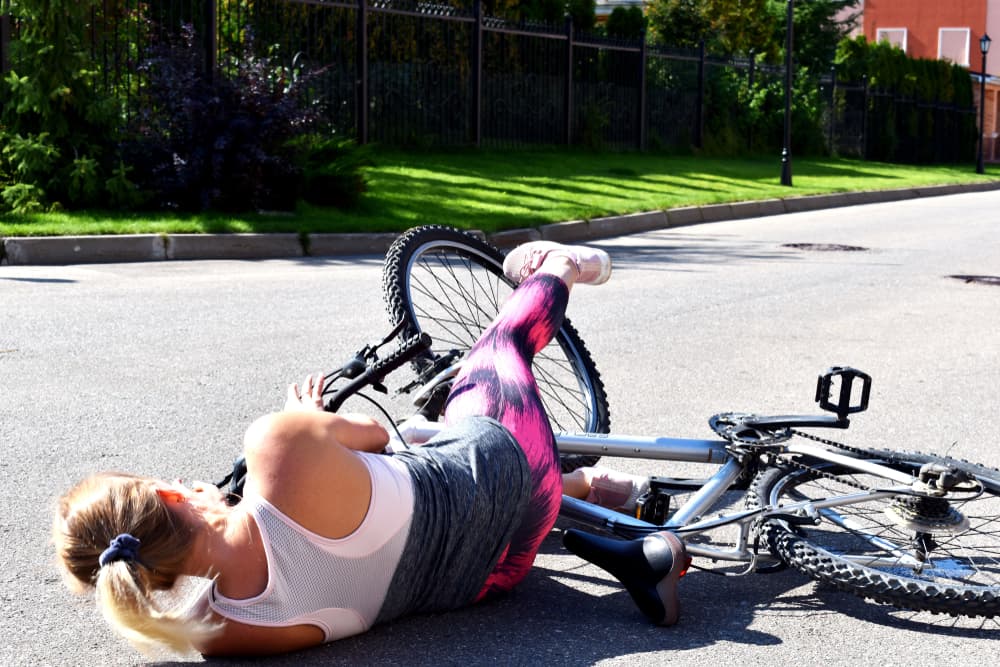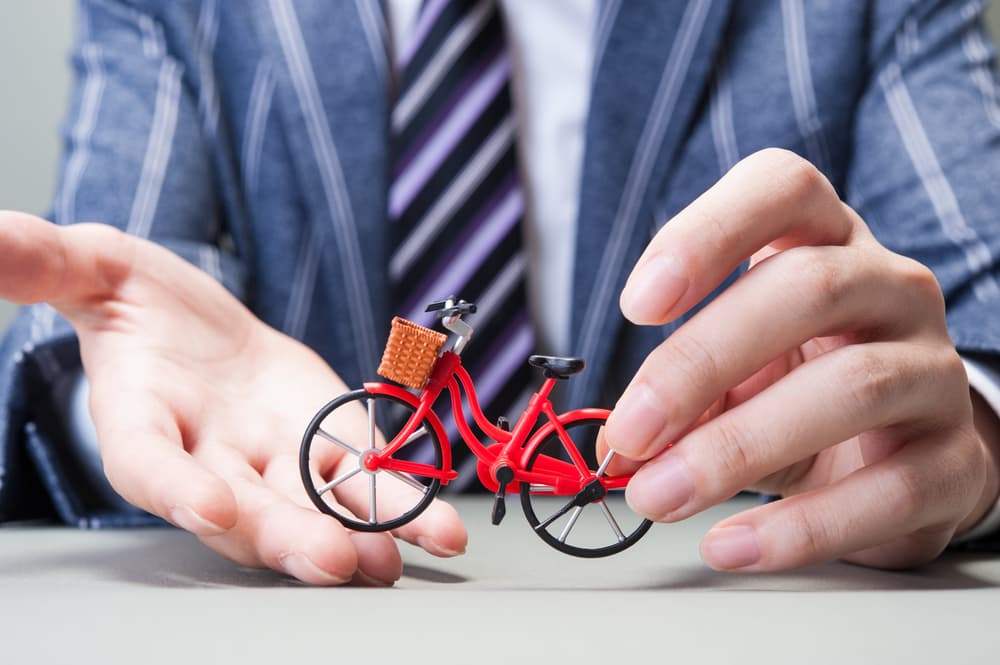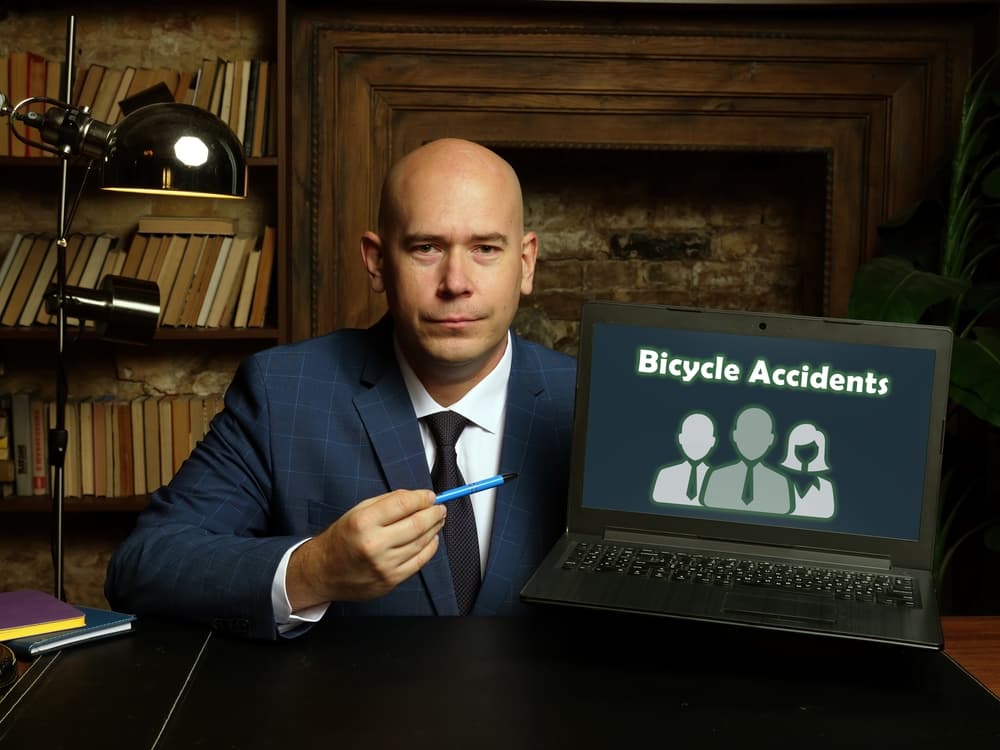Imagine riding your bicycle, enjoying the day, when suddenly a car swerves too close. You react quickly, veering away to avoid a collision, but you lose control and crash. The car never touched you, yet you are injured, and your bike is damaged.
This scenario, unfortunately common, raises a pressing question for many cyclists:
What Are No-Contact Bicycle Accidents and Can You Still Sue?
Defining a No-Contact Bicycle Accident
A no-contact bicycle accident occurs when a cyclist crashes and sustains injuries due to the negligent actions of a motorist, but the motor vehicle does not physically strike the bicycle or the cyclist.

The accident happens because the cyclist must take evasive action to prevent a direct collision with the car. For instance, a car might suddenly pull out from a side street without yielding, forcing the cyclist to brake hard and fall, or swerve into a curb or other hazard.
Even though the car and bicycle never made contact, the driver's conduct directly led to the cyclist's crash and subsequent injuries. These situations can be confusing for injured cyclists. Many people assume that the driver cannot be held responsible if the car did not hit them.
However, this is not always true. The law often recognizes that a driver's careless behavior can create a dangerous situation that directly causes harm, regardless of physical contact.
The key element is whether the driver’s actions were a primary cause of the cyclist's need to take immediate, evasive maneuvers that resulted in the crash.
Identifying these incidents as legitimate accidents for which a driver can be liable is the first step toward seeking compensation.
Here are a few common scenarios that qualify as no-contact bicycle accidents:
- A car suddenly cuts off a cyclist, forcing the cyclist to swerve off the road.
- A driver opens their car door into the path of an oncoming cyclist (dooring), causing the cyclist to crash while trying to avoid the door.
- A motorist makes an improper turn directly in front of a cyclist, leading the cyclist to brake sharply and fall.
- A driver aggressively tailgates a cyclist, creating an intimidating situation that causes the cyclist to lose control.
- A vehicle runs a red light or stop sign, and a cyclist with the right-of-way crashes while avoiding the car.
How Can a Driver Cause a No-Contact Accident?
Drivers have a duty to operate their vehicles with reasonable care and to be aware of other road users, including cyclists. When they fail in this duty, their negligence can lead to no-contact accidents. A driver does not need to hit a cyclist to be at fault.
Their careless actions alone can create a hazardous environment that directly results in a cyclist's injury. Many such incidents stem from a driver's failure to see the cyclist or disregarding traffic laws designed to protect vulnerable road users.
The core issue is often a breach of the driver's duty of care. This could involve a wide range of behaviors. For example, a driver distracted by a phone might drift into a bike lane, forcing a cyclist to swerve into traffic or onto a rough shoulder.
A driver speeding through a residential area might startle a cyclist into making a sudden, unsafe maneuver. Even actions that seem minor to the driver, like failing to signal a turn, can have serious consequences for a nearby cyclist who relies on those signals to anticipate traffic movements.
The absence of a collision does not excuse the driver's initial negligent act that set the chain of events in motion.
Driver actions that frequently lead to no-contact bicycle accidents include:
- Failure to Yield Right-of-Way: A driver might pull out from a driveway, parking spot, or side street without yielding to an approaching cyclist who has the legal right-of-way. The cyclist is then forced to take sudden action to avoid being hit.
- Unsafe Lane Changes or Merging: A motorist may change lanes or merge without checking their blind spot for a cyclist. This can force the cyclist to brake abruptly, swerve into another lane, or hit an obstacle.
- Running a Stop Sign or Red Light: When a driver disobeys traffic signals, cyclists who are lawfully proceeding through an intersection may have to perform emergency maneuvers, leading to falls or collisions with other objects.
- Distracted Driving: Drivers engaging in activities like texting, eating, or adjusting the radio may not notice a cyclist until the last second, causing the cyclist to react to the driver's erratic vehicle movement.
- Aggressive Driving: Speeding, tailgating, or intentionally crowding a cyclist can intimidate the rider, causing them to lose balance or swerve into a dangerous area to escape the perceived threat.
Proving Fault in a No-Contact Scenario
Establishing a driver's responsibility in a no-contact bicycle accident can present more challenges than in a collision case. Without the physical evidence of a crash, like vehicle damage or paint transfer, proving that the driver's actions caused your accident requires careful collection and presentation of other evidence.

The focus shifts to demonstrating that the driver was negligent and that their negligence directly forced you to take evasive action, which resulted in your injuries.
Successfully making your case often depends on piecing together a clear narrative of what happened. Witness testimony can be very valuable. If other people saw the driver's dangerous maneuver and your subsequent crash, their accounts can support your claim.
Police reports, if one was filed, might also contain useful information, especially if the officer noted contributing factors or interviewed witnesses at the scene. Your own detailed recollection of the event, written down as soon as possible, is also important.
These elements help build a persuasive argument that the driver, despite not making contact, is indeed liable.
Gathering Eyewitness Accounts
Witnesses can provide unbiased descriptions of the driver's actions and the cyclist's reaction.
- Statements from pedestrians, other drivers, or nearby residents who saw the incident.
- Information about what the driver did (e.g., swerved, ran a stop sign, sped).
- Confirmation that the cyclist had to take evasive action to avoid a direct hit.
Utilizing Available Video Footage
Surveillance cameras from nearby businesses or traffic cameras might have captured the event.
- Requesting footage from stores, homes with security cameras, or municipal traffic departments.
- Dashcam footage from your own bike or from other vehicles that were present.
- Video evidence can be very compelling in showing the driver's behavior.
Documenting the Scene and Your Injuries
Physical evidence, even without a collision, is still relevant.
- Photos of the accident location, noting road conditions, traffic signals, and sightlines.
- Pictures of your injuries immediately after the accident and during your recovery.
- Keeping all medical records and bills related to the injuries sustained.
Types of Injuries Common in These Accidents
Even though a vehicle does not directly strike the cyclist in a no-contact accident, the injuries sustained can be just as severe as those in a direct collision. The force of such impacts can lead to physical harm, from minor scrapes and bruises to life-altering conditions.
The nature of these crashes often means that cyclists have little time to protect themselves. The sudden need to avoid a car can result in uncontrolled falls.
Here's a look at injuries frequently seen:
- Head Injuries: Concussions, traumatic brain injuries (TBIs), skull fractures.
- Broken Bones: Fractures of the arms (radius, ulna, humerus), legs (tibia, fibula, femur), wrists, ankles, collarbone (clavicle), and ribs.
- Road Rash and Lacerations: Deep skin abrasions, cuts, and puncture wounds that may require stitches or lead to scarring.
- Spinal Cord Injuries: Damage to the vertebrae or spinal cord, potentially resulting in paralysis or long-term mobility issues.
- Soft Tissue Injuries: Sprains, strains, and tears of muscles, ligaments, and tendons, often affecting knees, shoulders, and back.
- Internal Injuries: Damage to organs, internal bleeding, which may not be immediately apparent.
Compensation You Might Recover
If you can successfully show that a driver's negligence caused your no-contact bicycle accident, you may be entitled to recover various forms of compensation.
The purpose of this compensation is to help restore you, as much as possible, to the financial position you were in before the accident and to acknowledge the physical and emotional hardship you have endured.
Economic Damages
These are quantifiable financial losses resulting from the accident.
- Medical Expenses: All costs for treatment, including emergency care, hospital stays, surgeries, doctor visits, physical therapy, medications, and future medical needs.
- Lost Wages: Income lost due to being unable to work during your recovery period.
- Loss of Earning Capacity: If your injuries permanently affect your ability to earn an income at your previous level.
- Property Damage: Costs to repair or replace your bicycle and any other personal property damaged in the crash (e.g., helmet, clothing, phone).
Non-Economic Damages
These compensate for the non-financial, personal toll of the accident.
- Pain and Suffering: Compensation for the physical pain, discomfort, and emotional distress caused by your injuries.
- Mental Anguish: For conditions like anxiety, depression, or post-traumatic stress disorder (PTSD) stemming from the traumatic event.
- Loss of Enjoyment of Life: If your injuries prevent you from participating in hobbies, recreational activities, or daily life as you did before.
- Disfigurement or Scarring: For permanent physical changes resulting from your injuries.
Being injured in a no-contact bicycle accident can be a frustrating and challenging experience. The first step is to contact an experienced bicycle accident lawyer to guide you through the troubling days ahead.
Steps to Take After a No-Contact Bicycle Accident
What you do in the days and weeks that follow the accident is significant for protecting your health and supporting any potential claim for compensation. Consistent follow-through on medical care and documentation becomes key during this period.
- Attend All Medical Appointments and Follow Treatment Plans: Your health is the priority. In the days and weeks following the accident, make sure you attend all scheduled doctor visits, physical therapy sessions, or specialist appointments. Follow the treatment plans prescribed by your healthcare providers carefully. This not only aids your recovery but also creates a clear medical record linking your injuries to the accident.
- Track How Your Injuries Affect Your Daily Life: Keep a simple journal or notes detailing your pain levels, any physical limitations you experience, and how your injuries affect your ability to perform daily tasks, work, or engage in hobbies. Note any sleep disturbances, emotional distress, or other ways the accident has affected your quality of life. This contemporaneous record can be very helpful later.
- Secure and Preserve Physical Evidence: Ensure that your damaged bicycle, helmet, torn clothing, or any other physical items involved in the crash are stored safely and not repaired or discarded. These items can serve as important evidence.
- Be Careful When Speaking with Any Insurance Adjusters: You may be contacted by insurance adjusters, either from your own company or representing the at-fault party if they are identified. While you must cooperate with your insurer to a certain extent, be mindful that adjusters for the other party are looking to minimize payouts. Avoid giving recorded statements or signing any documents without fully understanding their implications.
- Revisit the Accident Scene (If Safe and Able): Once you are feeling up to it, and if it's safe to do so, consider revisiting the accident scene during similar conditions (time of day, day of week). This can sometimes help you recall additional details about the incident or identify potential sources of evidence you might have missed, such as overlooked security cameras on nearby buildings.
Your Case Matters—Connect with Us Today

If you have been involved in a no-contact bicycle accident in Texas and are unsure about your rights or how to proceed, consider seeking guidance.
The team at Lorenz & Lorenz, PLLC, is experienced in helping individuals who have been injured due to the negligence of others. We offer a free consultation to discuss the specifics of your situation.
You can reach us at (512) 477-7333 to speak with someone who can assist you.